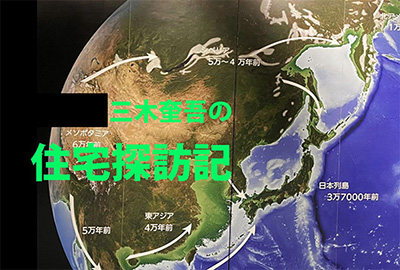


最近、ブログの記述範囲がやや、あちこち拡散気味。
基本は暮らしと住宅というテーマ。ただ、先日来書いていたように
思索を重ね記録していた画像データの外付けSSDドライブの
アクセス不能で積み重ねてきたテーマ集中データを参照できないので
どうも自分自身の再構築に時間が掛かってしまっています。
そんななかで「日本列島37,000年史」ブログの試みに挑戦。
写真データは過去の取材写真で国立歴史民俗博物館・先史展示から。
旧石器時代というのは今から約3万8千年前から1万6千年前の約2万2千年間。
人々はまだ土器を持たず、主に打ち欠きによって作られた打製石器や
動物の骨や角を用いて作られた骨角器を使い狩猟や採集活動を行っていた。
日本列島ではこの時代から人間活動が展開されてきた。
さまざまな事物の探究の中から、いちばん上の表現イラストのような
「こころ」の世界があきらかにされてきているという。
歴史民俗博物館の研究者たちの「集団意思」として確定しているのでしょう。
・変換ネットワーク
・発明能力
・資源開発の計画性
・抽象的思考
という4つのこころの発展実相について史的妥当性を認めている。
こうしたこころが我々現代人にまで伝わる暮らし方の基盤を形成する。
「変換ネットワーク」ということについては、すでに交易実態があることで
容易に理解できる。北海道の黒曜石が本州地区で発掘されることで
このことはあきらか。そして当然「資源開発の計画性」ということにも
このことは密接に繋がってくる。
入手した黒曜石を利用して生活有用物の採取を計画的に実行する社会があった。
「発明能力」もまた、当然、交易活動の基盤であっただろう。
ある有用材が流通するためには、交換可能な有用材を自らも開発努力する
必要性が当然のようにあったことだろう。
「あそこに行けばこれが得られる」という魅力が交易活動の条件。
逆に言えば、そういう努力がなければ自立生活も難しかっただろう。
最後の「抽象的思考」というのがきわめて興味深い。
暮らしを豊かにして行く、社会の生産性を向上させるには
こうしたこころの進化発展が不可欠ということでしょう。
こうした20,000年を超える時間蓄積からやがて縄文という時代に移行し
現代人まで繋がってくる日本列島での人間社会が実現してきた。
はるかな叡智の連綿とした継続が現代社会に投影されているのでしょう。
で、現代人的行動というものを抽象化させるのに
・時間の管理
・交換体系
・情報ネットワーク
という3つの要素にまとめ上げられていた。
こういった先史と現代のシンクロという視点はいろいろな気付きに繋がる。
このパネル1枚を契機とした歴史民俗博物館研究員さんとの「対話」は有益。
もっと深くコミュニケーションしたくなりますね。
訪問後、ずっと思索を温めていくのに写真記録を残していてよかった。
自分の気付きの痕跡を残すのはいかに大事か、よくわかります。
English version⬇
The “Heart” of Paleolithic Human Origin: The 37,000-Year History of the Japanese Archipelago-2
The traces of human beings in the archipelago reveal the social reality of “trade. The conditions for the establishment of such a society reveal the basis for its progress and development. The history of the Japanese archipelago
Recently, the scope of my blog posts has been spread out a bit here and there.
The basic theme is living and housing. However, as I wrote the other day
I can’t access to the external SSD drive of the image data that I have been contemplating and recording, so I can’t refer to the thematic data that I have accumulated.
I can’t access the image data on the external SSD drive, so I can’t refer to the theme-intensive data that I’ve accumulated.
It is taking me a long time to reconstruct myself.
In such a situation, I tried an attempt of “37,000-year history of the Japanese archipelago.
The photo data is from the National Museum of Japanese History, Prehistory Exhibition.
The Paleolithic period was about 22,000 years ago, from 38,000 to 16,000 years ago.
People did not have earthenware yet, but used mainly chipped stone tools and bone tools made from animal bones and horns.
They hunted and gathered using bone and antler implements made from animal bones and horns.
In the Japanese archipelago, human activities have developed since this period.
From the exploration of various things, the world of the “heart,” as shown in the illustration above, has been revealed.
The world of “Kokoro” (heart) has been revealed through the exploration of various things, as shown in the illustration above.
This is probably confirmed as the “collective will” of the researchers at the Museum of History and Folklore.
Transformation Network
Ability to invent
Planning ability of resource development
Abstract thinking
The researchers have accepted the validity of the four mental realities of “the mind of the people.
These mental realities form the basis of the way of life that has been handed down to us modern people.
The “transformation network” can be easily understood by the fact that there is already a trade reality.
It is easy to understand. The fact that obsidian from Hokkaido has been excavated in the Honshu region is a clear indication of this.
This is obvious. And of course, this is closely related to the “planned nature of resource development.
This is closely related to the “planning of resource development.
There were societies that planned to use the obsidian they obtained to collect useful materials for daily life.
Inventive capacity” would also have been the basis for trading activities.
In order for a useful material to be distributed, it would have been necessary to develop a useful material that could be exchanged for it.
In order for a certain useful material to be distributed, there would naturally have been a need to develop useful materials that could be exchanged.
The condition for trading activities is the attractiveness of “if you go there, you can get this”.
Conversely, without such efforts, it would have been difficult to live independently.
The last point, “abstract thinking,” is extremely interesting.
In order to enrich people’s lives and improve the productivity of society
the evolution and development of the mind is indispensable to enrich our lives and improve the productivity of society.
From this accumulation of more than 20,000 years of time, we eventually shifted to the Jomon period and realized a human society that is connected to the modern people.
This is the origin of the human society that is connected to the modern human race.
The continuity of far-reaching wisdom is projected onto modern society.
And, to abstract the modern human behavior, we can use the following terms.
Time management
Exchange systems
Information network
The three elements were summarized as “time management,” “exchange systems,” and “information networks.
This perspective of synchronizing prehistory and modernity leads to various insights.
The “dialogue” with the researcher of the Museum of History and Folklore, which was triggered by this one panel, was beneficial.
It makes me want to communicate more deeply.
I am glad I kept a photographic record to warm up my contemplation long after the visit.
I understand how important it is to leave traces of one’s findings.
Posted on 10月 7th, 2022 by 三木 奎吾
Filed under: 日本社会・文化研究, 歴史探訪







コメントを投稿
「※誹謗中傷や、悪意のある書き込み、営利目的などのコメントを防ぐために、投稿された全てのコメントは一時的に保留されますのでご了承ください。」
You must be logged in to post a comment.